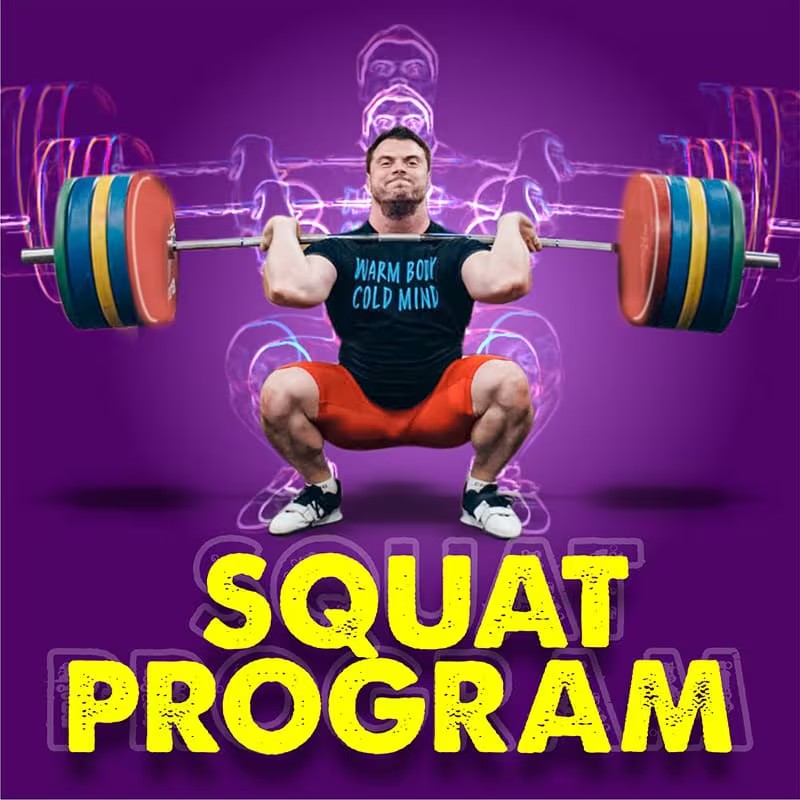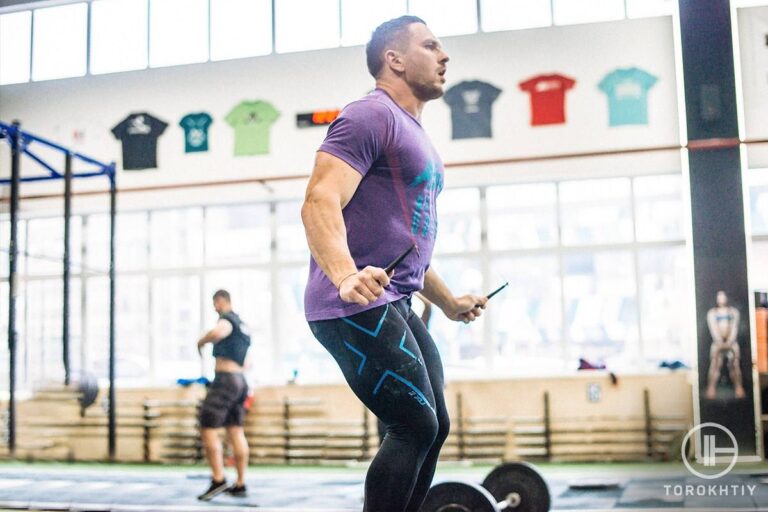Squat Pyramid: What Is It & How To Create Your Own
Reviewed by: Jacek Szymanowski (Certified Nutritionist, S&C specialist, M.Sc.Eng. Biotechnology)
Are you ready to elevate your strength training with the strategy that challenges your limits and promises substantial gains? Enter the squat pyramid – systematic approach that not only builds muscle, but also fortifies your mental grit.
This method involves incrementally increasing and then decreasing the weight or reps in your squats, forming a pyramid-like structure in your workout plan.
Squat pyramid is a structured workout approach where you incrementally increase, then decrease the weight or reps of squats. This creates a pyramid-like pattern in routine, effectively building muscles and improving endurance through systematic progression and intensity management.
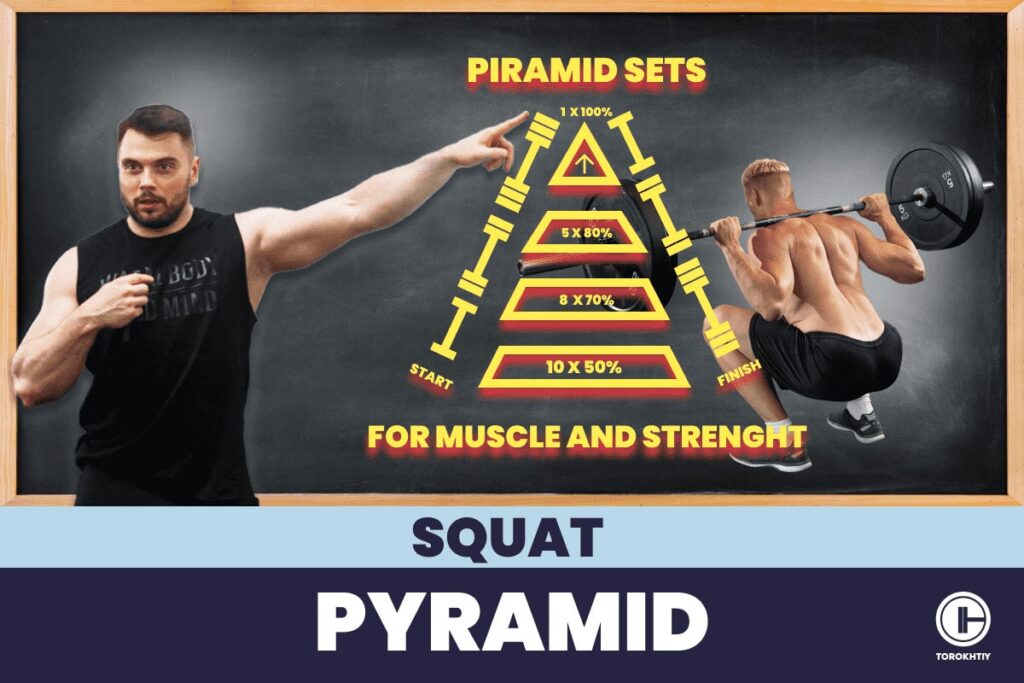
The beauty of the squat pyramid lies in its simplicity and adaptability, catering to beginners and seasoned lifters alike. With each ascending and descending set, you push through boundaries enhancing not just muscle endurance, but also boosting your confidence as you witness tangible progress.
Embrace the squat pyramid and watch as it revolutionizes your time under the bar, one rep at a time.
What is a Pyramid Training Method?
Embarking on the squat pyramid journey starts with understanding its foundational concept – a structured progression that visualizes your path to strength building. Imagine a chart: at its base you have lighter weight or more repetitions, and as you move up the pyramid, the weights grow heavier or reps decrease, picking at your maximum effort.
Then, like descending a mountain, you reduce the load step-by-step back to where you started. This squat pyramid chart doesn’t just represent your workout visually. It symbolizes the gradual climb towards peak physical prowess.
Squat Pyramid – What Is It?
The structure of a squat pyramid workout is methodical – it begins with a warm-up set at a comfortable weight, progressing into heavier sets, increment by increment. Upon reaching the apex where you test your limits, the journey down begins systematically decreasing the weight again.
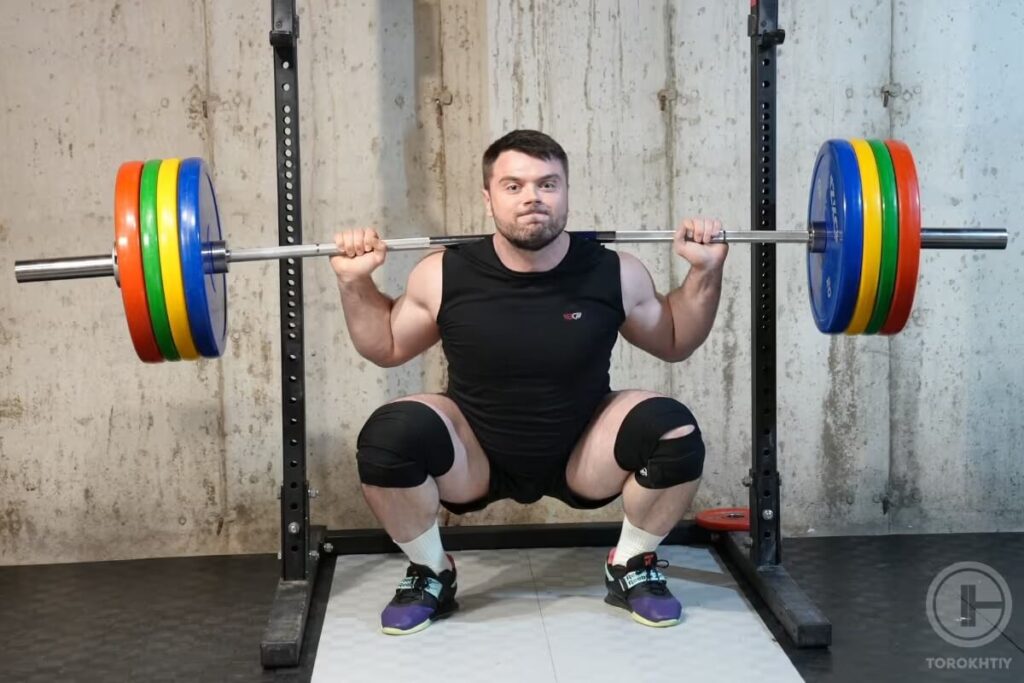
Such incremental progression is pivotal in building, both strength and muscular endurance. It allows the body to adapt to stressors progressively minimizing risk of injury, while maximizing muscle recruitment. This approach not only enhances your physical capacity, but also in a sense of accomplishment as you ascend and descend the pyramid rep by rep.
Crafting Squat Pyramid Workout
Building your very own squat pyramid workout is an interesting process that tailors to your individual strength and goals. Here’s how you can design a workout that challenges you appropriately with an emphasis on safety and proper form.
Step 1: Establish Your Base
Determine a comfortable starting weight you can perform for 10-12 reps with immaculate form. This becomes the foundation of your pyramid.
Step 2: Ascending the Pyramid
Increase the weight incrementally with each set while reducing the reps. Your increments can be as small as 5-10 lbs aiming for 1-2 reps less per set. This gradual climb helps your muscles for the heavier loads to come.
Step 3: Reaching the Summit
Identify a peak weight for today’s workout, typically a load you can perform for 2-3 clean, challenging reps. This is the pinnacle of your pyramid, so brace for intensity and focus on maintaining control.
Step 4: Descending with Control
After picking, reduce the weight in the same increments, increasing the reps again. Descending is not just a cool-down, it’s an integral part of building, endurance and reinforcing muscle memory.
Throughout your workout, it’s crucial to stay tuned to your body. Safety is Paramount so heed these tips:
1. Warm Up Adequately
A comprehensive warm up, primes your muscles and joints, setting you up for success.
2. Maintain Proper Form
Even as you tire, never compromise on form. This helps prevent injury and ensures that you are engaging the right muscles.

3. Rest Appropriately
Allow for recovery between sets, especially as you approach to Max weights
4. Listen to Your Body
If something feels off, don’t push it. The pyramid can be climbed again another day.
The squat, pyramid workout isn’t just about building strength, it’s about proving to yourself that with each lift, you are capable of reaching your new heights.
Navigating the Levels of Squat Pyramid
Pyramid squats are the embodiment of progressive overload, a method where you systematically challenge your muscles by manipulating the intensity levels as you progress through each level of your squat pyramid, you encounter vain degrees of intensity, each designed to build different aspects of strength and power.
1. Begin With Endurance
Your pyramid starts with higher reps and lower weight. This level focuses on muscular endurance and perfecting form.
2. Move to Building
As you as the pyramid, the wraps decrease while the weight increases. This middle ground is where you build muscle and neural adaptations crucial for the next stage – maximal strength.
3. Peak With Intensity
At the apex, you are at your heaviest weights with the lowest rep count. This is where you push your limits, lifting to near your one rep max for a 1 rep or 2. It’s intense, it’s challenging and it’s where significant strength gains are made.
4. Descend With Volume
Coming down the pyramid, you are back to decreasing weights and increasing the number of reps. This not only helps in muscle memory, but also reinforces technique under fatigue – a key factor for growth and endurance.
Breaking through plateaus requires strategic variation. Introduce pauses at the bottom of your squats, play with feet stance, adjust your rest intervals or your rep speed. Small tweaks can lead to big leaps overtime.
Remember that your body’s feedback is paramount. Each level should be challenging, but never at the cost of your well-being. As you push your boundaries, do so with a keen awareness of what your body tells you. Fatigue is expected, but pain is a signal to reassess and adjust.
Squat Pyramid Session – Where To Start
Now let’s look at the three detailed templates for a squat pyramid workout, tailored to different training levels, along with warm-up drills and accessory exercises.
1. Squat Pyramid for Beginners
Warm-up drills:
Bodyweight squats: 2 sets of 15 reps (focus on depth and form)
Leg swings: 10 swings per leg, both front-to-back and side-to-side
Walk lunges: 2 sets of 10 reps per leg (add twists to engage the core)
Squat pyramid (Volume and Intensity):
- Set 1: 12 reps at 50% of estimated 1RM
- Set 2: 8 reps at 55%
- Set 3: 6 reps at 65%
- Set 4: 8 reps at 55%
- Set 5: 12 reps at 50%
- Rest for 1-2 minutes between each set.
Accessory exercises:
Leg press: 3 sets of 12 reps
Goblet squats: 3 sets of 10 reps
Planks: 3 sets for 30 seconds
Squat Pyramid for Advanced Lifter
Warm-up drills:
Dynamic Stretches: including high knees and butt kicks for 5 minutes
Resistance Band Side Walks: 2 sets of 10 steps each direction
Jump Squats: 2 sets of 10 reps (to engage fast-twitch fibers)
Squat pyramid:
- Set 1: 10 reps at 60% of 1RM
- Set 2: 8 reps at 70%
- Set 3: 6 reps at 75%
- Set 4: 4 reps at 80%
- Set 5 (peaking): 2 reps at 85%
- Set 6: 4 reps at 80%
- Set 7: 6 reps at 75%
- Set 8: 8 reps at 70%
- Set 9: 10 reps at 60%
- Rest for 2-3 minutes between each set.
Accessory exercises:
Romanian Deadlifts: 4 sets of 8 reps
Bulgarian Split Squats: 3 sets of 10 reps per leg
Hanging Leg Raises: 3 sets of 12 reps
Squat Pyramid for Professionals
Warm-up drills:
Barbell warm-up complex: including good mornings, back squats, overhead presses (empty bar) for 2 sets of 5 reps each
Box Jumps: 3 sets of 5 reps
Hip Thrusters: 2 sets of 10 reps with moderate weight
Squat pyramid:
- Set 1: 8 reps at 70% of 1RM
- Set 2: 6 reps at 80%
- Set 3: 3 reps at 90%
- Set 4: 2 reps at 95%
- Set 5 (peaking): 1 rep at 100%
- Set 6: 2 reps at 95%
- Set 7: 3 reps at 90%
- Set 8: 6 reps at 80%
- Set 9: 8 reps at 70%
- Rest intervals should be 3-5 minutes as you approach and descend from the peak to ensure full recovery.
Accessory exercises:
Front Squats: 4 sets of 5 reps
Weighted Step-Ups: 4 sets of 6 reps per leg
Calf Raises: 5 sets of 15 reps
Feel free to adjust the weights, reps and rest intervals based on personal comfort and safety. Always prioritize form over weight to ensure the effectiveness of workout and prevent injuries.
🔻12 Week Squat Program by Oleksiy Torokhtiy
Do you want to double your squat strength? In just 12 weeks, you’ll be able to boost your squat results.
This program transforms any ordinary squat into a powerful athletic movement.
What’s included:
- 12 weeks of squat programming;
- Effective combination of sets, reps, and weights;
- Fully designed and coached by Oleksiy Torokhtiy;
- Over 60+ movements, banded work, and weight training;
- Accessory work for core, joint stability and injury prevention;
- Max out on back squat and front squat at the end.
Start now and boost your squat results!
Mastering the Squat Pyramid
Reaching the peak of your squat pyramid workout is a milestone moment in your training. It requires pushing through the mental and physical barriers that often limit us. When you are ready to increase weights, do so incrementally.
Listen to your body and ensure that each weight progression maintains proper form. It’s not about how heavy you lift, but how well you lift heavy.
The peak is intense, so your recovery should be equally prioritized. Integrating rest and recovery strategies such as proper nutrition, hydration and sleep are crucial for your muscles to repair and grow. Active recovery like light cardio or mobility to work can also facilitate quicker muscle recuperation.
As you can require each pyramid level, take the time to celebrate these wins. They are proof of your dedication and stepping stone to even higher goals. Set your next targets with the balance of ambition and realism, pushing the envelope a bit further each time.
4 Squat Pyramid Variations
To keep your training, engaging and challenging, consider integrating different pyramid variations. Adjust the weight increments, alter the number of reps or change the pace of your set.
Incorporating techniques like pause reps, explosive lifts or varying your group or feet stance can further enhance muscle engagement and strength gains, providing a fresh challenge and helping to break through performance plateaus.
Here are squat pyramid variations to enhance your training:
1. Reverse Pyramid Training
Start with your heaviest set at lower reps and gradually decrease the weight while increasing the reps in subsequence sets. This method maximizes strength and muscle endurance by initially challenging your muscles when they are freshest.
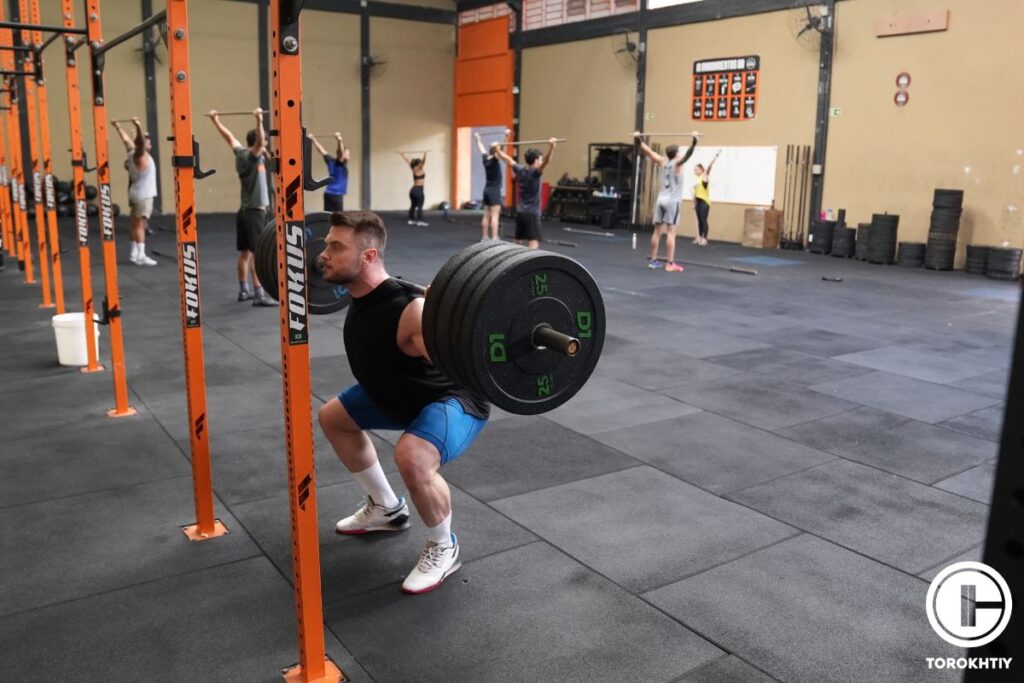
2. Volume Pyramid
Focus on increasing the number of reps instead of the weight. Begin with a few reps, and with each side gradually increase the reps to peak before descending back to the starting point. This variation emphasizes endurance and muscle hypertrophy.
3. Weighted Pyramid
Incorporate different weights in each set, without changing number of reps, ascending to the heaviest and then descending back adjust the increments between sets to suit your strength levels, ensuring each set pushes your limits appropriately.
4. Time Based Pyramid
Instead of focusing on reps or weight, use time under tension. Perform squats for a set time period, increasing the duration each set until you reach a peak, then decrease the time for each subsequent set.
FAQ
How Many Reps Is A Pyramid?
The number of reps in the pyramid workout can vary widely depending on the specific goals and structure of the program. Typically pyramids might start with higher reps (12-15) and lower weights, peak with fewer reps (1-3) at higher weights, and then descend back to higher reps at lower weights.
Do Pyramid Sets Build Muscle?
Yes, the pyramid method is effective for building muscles. It combines high volume with increasing intensity, which helps maximize muscle hypertrophy by exposing muscles to a variety of stimuli, enhancing both strength and endurance within a single workout.
Conclusion
In the essence of your squat pyramid, each level scaled has fortified not just your muscles, but your spirit. You have learned the rhythm of progression, the balance of intensity and recovery and the sweet victory of suppressing your previous bounds.
This journey you are on transcend the weights you lift – it molds your character, teaching patience, persistence and grit.
Let your achievements be a beacon for others. Share your story, inspire fellow lifters and join the community conversation. What heights have you reached with your squat pyramid? How has it transformed your training? Climb, conquer and then, let’s celebrate every milestone together.
References:
- Enes A, Oneda G, Leonel DF, Ramos RA, Kvas-Cabral VC, Bernardo MF, Escalante G, Souza-Junior TP. Drop-Set Resistance Training versus Pyramidal and Traditional Sets Elicits Greater Psychophysiological Responses in Men. Percept Mot Skills. 2023 Aug;130(4):1624-1643. doi: 10.1177/00315125231176729. Epub 2023 May 17. PMID: 37197987.
- González-Hernández JM, Jimenez-Reyes P, Janicijevic D, Tufano JJ, Marquez G, Garcia-Ramos A. Effect of different interset rest intervals on mean velocity during the squat and bench press exercises. Sports Biomech. 2023 Jul;22(7):834-847. doi: 10.1080/14763141.2020.1766102. Epub 2020 Jun 22. PMID: 32567492.
- Adelsberger R, Tröster G. Effects of stretching and warm-up routines on stability and balance during weight-lifting: a pilot investigation. BMC Res Notes. 2014 Dec 20;7:938. doi: 10.1186/1756-0500-7-938. PMID: 25527262; PMCID: PMC4326506.
- Martínez-Cava A, Hernández-Belmonte A, Courel-Ibáñez J, Conesa-Ros E, Morán-Navarro R, Pallarés JG. Effect of Pause Versus Rebound Techniques on Neuromuscular and Functional Performance After a Prolonged Velocity-Based Training. Int J Sports Physiol Perform. 2021 Jul 1;16(7):927-933. doi: 10.1123/ijspp.2020-0348. Epub 2021 Feb 9. PMID: 33561819.
- Helland C, Midttun M, Saeland F, Haugvad L, Schäfer Olstad D, Solberg PA, Paulsen G. A strength-oriented exercise session required more recovery time than a power-oriented exercise session with equal work. PeerJ. 2020 Sep 30;8:e10044. doi: 10.7717/peerj.10044. PMID: 33062443; PMCID: PMC7532781.
- Photos made by Torokhtiy Media Team.
Why Trust Us?
With over 20 years in Olympic Weightlifting, our team does its best to provide the audience with ultimate support and meet the needs and requirements of advanced athletes and professional lifters, as well as people who strive to open new opportunities and develop their physical capabilities with us.
By trusting the recommendations of our certified experts in coaching, nutrition, dietology, and sports training programming, as well as scientific consultants, and physiotherapists, we provide you with thorough, well-considered, and scientifically proven content. All the information given in the articles concerning workout programming, separate exercises, and athletic performance, in general, is based on verified data. We ensure that you can rely on our professionals’ pieces of advice and recommendations that can be treated as personalized ones which will benefit you and fully meet your needs.
The product testing process is described in more detail here
Author: Ihor Shymechko
Pro Olympic Weightlifter, Coach
Best Results: Snatch – 208 kg,
C&J – 240 kg
Ihor has been a professional weightlifter since 1996, boasting over two decades of competition experience. His notable achievements include clinching the European Championship in 2009 and securing a silver medal in the 105kg division at the Senior World Championships in 2011. Ihor represented his country in the 2008, 2012, and 2016 Summer Olympics. After retiring from competitive weightlifting, he transitioned to coaching, leveraging his vast experience to guide athletes who now compete on both national and international stages.
Reviewed by: Jacek Szymanowski
Certified Nutritionist,
M.Sc.Eng. Biotechnology
Performance architect,
Strength and Conditioning Specialist
With over 30 years of fighting experience, specialization in nutrition coaching for athletes, and expertise in metabolic health and dietary strategies, Jacek offers a comprehensive approach to optimizing your performance and well-being. Backed by a Master of Science degree in Biotechnology, Jacek remains at the forefront of scientific advancements, ensuring that his coaching is always evidence-based and up-to-date.

